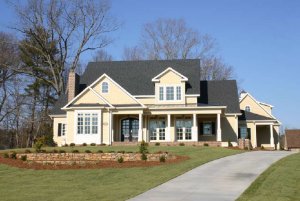Green Building
Homeowners are increasingly interested in green building. But what exactly makes a home green?
All homes built by Alan Fletcher Construction meet or exceed guidelines set by Energy Star. Verification for ENERGY STAR qualification includes third party review of building plans and specifications as well as three trips to the job site by an independent auditor.
Energy Star is a great place to start but there is more to green building than just energy efficiency.
Green building means improving the way that homes and homebuilding sites use energy, water, and materials to reduce impacts on human health and the environment. Building a green home means making environmentally preferable and sustainable decisions throughout the building process - decisions that will minimize the environmental impact of the home while it is being built and over the many years it will be lived in.
We have adapted the following guiding principles from The National Association of Home Builders Green Building Program:
Lot Design, Preparation and Development
Creating a resource-efficient site design and implementing proper development practices helps reduce the environmental impacts and improve the energy performance of new housing. For instance, site design principles such as saving trees, constructing onsite storm water retention/infiltration features, and orienting houses to maximize passive solar heating and cooling are basic processes used in the design and construction of green homes.
Energy Efficiency
All homes built by Alan Fletcher Construction meet or exceed guidelines set by Energy Star. While protecting the environment, our homes provide better air quality and save money on utility bills. For example, all of our homes use instant tankless hot water heaters. This is more efficient because hot water is heated as it is needed instead of having a tank that keeps hot water stored at all times.
As the cost to heat and cool a home becomes more unpredictable, it is advantageous to every homeowner to be "insulated" from inevitable utility bill increases. The greatest improvements in energy efficiency result from a "whole systems" approach. Energy performance does not end with increased R-values and the use of Low-E glass, the use of renewable energy, and/or more efficient HVAC equipment. Rather, we balance these features and others such as an air sealing package, sealed crawlspace and attics, an interior entrance to crawlspace, 2x6 exterior walls with R-19 insulation to create a truly high-performance, energy efficient home that is less expensive to operate and more comfortable to live in than a conventionally constructed home.
Water Efficiency
Green homes often conserve water both indoors and out. More efficient water delivery systems indoors and native and drought-resistant landscaping choices outdoors can help prevent unnecessary waste of valuable water resources.
The mean per capita indoor daily water use in today's homes is slightly over 64 gallons. Implementing water conservation measures can reduce usage to fewer than 45 gallons. Our homes employ more efficient water delivery through the installation of instant hot water systems which are 30-45% more efficient, energy efficient appliances and EcoAir plumbing fixtures. Our energy efficient dishwashers incorporate advanced technologies that use 10-50% less energy and water than standard models. All faucets (except for the kitchen) and shower heads are air induced to increase pressure and are installed with aerators which reduce the gallons per minute to 1.6 compared to regular faucets and shower heads that are 2.5. All toilets are dual flush which has a partial flush of .8 gallons per minute and a full flush of 1.6 gallons per minute.
Care should be taken to preserve trees and other vegetation native to the area. The landscaping should contain plants that are appropriate for the climate, and are grouped according to water needs.
Indoor Environmental Quality
Recently, an increase in reported allergies and respiratory ailments has been reported. The use of chemicals that can off-gas from building materials have contributed to a heightened awareness of the air we breathe inside our homes. Even though there is no authoritative definition of healthy indoor air, there are measures that can mitigate the effects of potential contaminants including controlling the source, diluting the source, and capturing the source through filtration. We incorporate humidifiers and central vacuum systems to reduce allergies and produce a healthy environment. Our homes also incorporate a fresh air exchanger to mix outdoor with indoor air. Also available is an Energy Recovery Ventilation System (ERVS) which goes a step further in conditioning the fresh air.
Operation, Maintenance and Homeowner Education
Improper or inadequate maintenance can defeat our best efforts to create a resource efficient home. Homeowners often fail to change air filters regularly or neglect to operate bath and kitchen exhaust fans to remove moist air. To discourage this, we install energy efficient exhaust fans with timer switches in each bath to cycle fresh air inside and release the stale air outside. We also encourage good recycling habits in our green homes by incorporating recycling containers into the kitchen cabinetry design and we locate a recycling center in the garage.
![]() Team up with Alan Fletcher Construction to build your ultimate custom home
Team up with Alan Fletcher Construction to build your ultimate custom home





